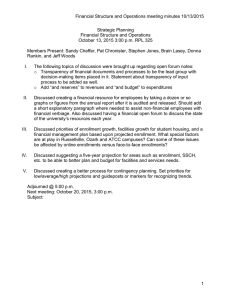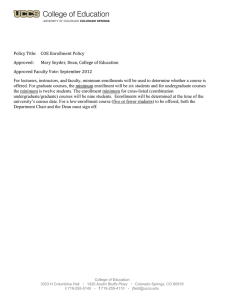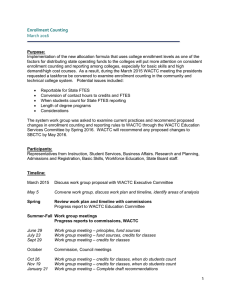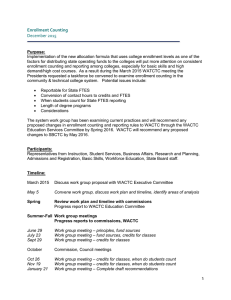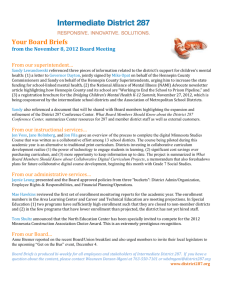W A C
advertisement
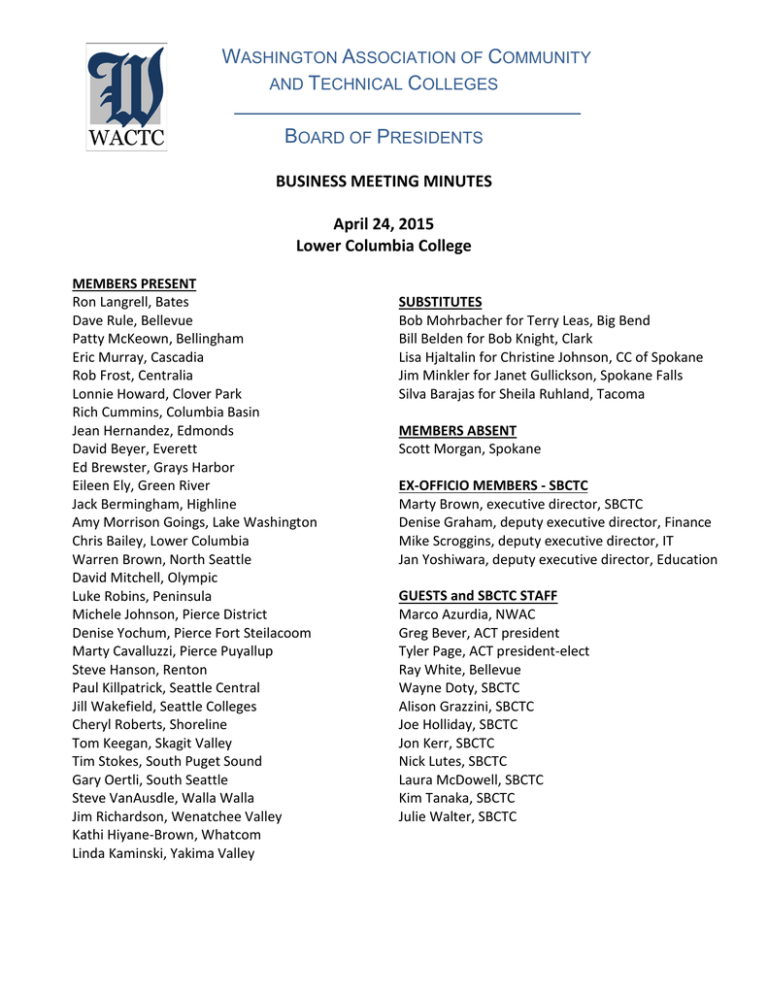
WASHINGTON ASSOCIATION OF COMMUNITY AND TECHNICAL COLLEGES BOARD OF PRESIDENTS BUSINESS MEETING MINUTES April 24, 2015 Lower Columbia College MEMBERS PRESENT Ron Langrell, Bates Dave Rule, Bellevue Patty McKeown, Bellingham Eric Murray, Cascadia Rob Frost, Centralia Lonnie Howard, Clover Park Rich Cummins, Columbia Basin Jean Hernandez, Edmonds David Beyer, Everett Ed Brewster, Grays Harbor Eileen Ely, Green River Jack Bermingham, Highline Amy Morrison Goings, Lake Washington Chris Bailey, Lower Columbia Warren Brown, North Seattle David Mitchell, Olympic Luke Robins, Peninsula Michele Johnson, Pierce District Denise Yochum, Pierce Fort Steilacoom Marty Cavalluzzi, Pierce Puyallup Steve Hanson, Renton Paul Killpatrick, Seattle Central Jill Wakefield, Seattle Colleges Cheryl Roberts, Shoreline Tom Keegan, Skagit Valley Tim Stokes, South Puget Sound Gary Oertli, South Seattle Steve VanAusdle, Walla Walla Jim Richardson, Wenatchee Valley Kathi Hiyane-Brown, Whatcom Linda Kaminski, Yakima Valley SUBSTITUTES Bob Mohrbacher for Terry Leas, Big Bend Bill Belden for Bob Knight, Clark Lisa Hjaltalin for Christine Johnson, CC of Spokane Jim Minkler for Janet Gullickson, Spokane Falls Silva Barajas for Sheila Ruhland, Tacoma MEMBERS ABSENT Scott Morgan, Spokane EX-OFFICIO MEMBERS - SBCTC Marty Brown, executive director, SBCTC Denise Graham, deputy executive director, Finance Mike Scroggins, deputy executive director, IT Jan Yoshiwara, deputy executive director, Education GUESTS and SBCTC STAFF Marco Azurdia, NWAC Greg Bever, ACT president Tyler Page, ACT president-elect Ray White, Bellevue Wayne Doty, SBCTC Alison Grazzini, SBCTC Joe Holliday, SBCTC Jon Kerr, SBCTC Nick Lutes, SBCTC Laura McDowell, SBCTC Kim Tanaka, SBCTC Julie Walter, SBCTC CALL TO ORDER & WELCOME Ed Brewster, WACTC president, called the meeting to order at 8 a.m., welcomed those present, thanked Chris Bailey and Lower Columbia College staff for hosting the meeting, and asked for selfintroductions. APPROVAL OF MINUTES MOTION: It was moved and seconded that WACTC approve the March 27, 2015 minutes without corrections. MOTION PASSED. TREASURER’S REPORT Jim Richardson presented the WACTC Treasurer’s Report with an ending balance of $25,284.32 as of April 15, 2015. NORTHWEST ATHLETIC CONFERENCE (NWAC) REPORT – Marco Azurdia, NWAC executive director Marco Azurdia, NWAC executive director, congratulated Centralia College for receiving the 2014 President’s Cup, which honors academic achievement of athletics. He briefly discussed NWAC’s work with the Office of Financial Management on the increasing cost of insurance. NWAC is also working with the Attorney General’s Office on scholarships and a transgender policy. EXECUTIVE COMMITTEE REPORT – Ed Brewster, WACTC president • President-elect MOTION: It was moved and seconded that WACTC appoint Gary Oertli as the 2015-16 WACTC president-elect. MOTION PASSED. • Allocation Subcommittee update During the previous day’s Presidents Academy, the Allocation Subcommittee provided a brief overview of their work, reviewed the policy principles used during their discussions, and presented their recommendations on the final variables to be included in the model. The May meeting will be extended to include Wednesday, May 27, to continue the discussion. The afternoon will be broken into individual educational sessions on the final variables. The sessions will be a deep dive into the information the subcommittee received throughout the year and how they arrived at their recommendations. April 24, 2015 2 • WACTC Constitution According to the WACTC Constitution, only members of WACTC can vote on action items. Ex-officio members and representatives are not allowed to cast a vote. In preparation of action on the allocation model recommendations, it was agreed that arrangements would be made to facilitate electronic voting by absent members. The electronic vote will be available for one week following the meeting. The executive committee will discuss amending the constitution allowing representative to vote on behalf of their president or chancellor. • WACTC Summer Retreat: July 29-31, 2015, Sun Mountain Lodge, hosted by Wenatchee Valley College. • Bates Technical College update CRITICAL ISSUES COMMITTEE REPORT – Kathi Hiyane-Brown, chair • International student counting options The committee presented two options for counting international students and discussed the value statements, pros and cons, and implementation issues of each option. Option 1: Code all international students in state-funded courses as International Contract FTE, and maintain third-party contracts for International Contract programs. Option 2: Limit state-funded international student FTE to a percentage, still to be determined, of each district’s state enrollment target. Districts count all other international students in statesupported courses as International Contract, and maintain third party contracts for International Contract programs. MOTION: It was moved and seconded that WACTC approve to limit counting international students in state-supported courses as state-funded to a percentage, still to be determined, of each district’s state enrollment target. Districts count all other international students in state-supported courses as International Contract, and maintain third-party contracts for International Contract programs. Furthermore, any international student counted to reach a district’s enrollment target will not be weighted within the new allocation model. MOTION PASSED. April 24, 2015 3 MOTION: It was moved and seconded that WACTC approve to limit counting international students in state-supported courses as state-funded to 2 percent of a district’s state enrollment target or the number necessary to reach target, whichever is less. MOTION PASSED. • Additional Issues The committee also discussed international contract students not contributing to certain system and district funds. The committee recommends that international contract students pay into the Building Fee and Innovation Accounts, and, potentially, local Services and Activities Accounts. The Business Affairs Commission will be asked to develop recommendations by the July 2015 retreat on the following implementation issues: o The calculation and basis for the charge. o Whether the charge is additional or carved out of the current enrollment fee. o The timing for implementation. See Attachment A for the full analysis of the two options for counting international students and additional issues discussed by the committee. LEGISLATIVE & PUBLIC INFORMATION COMMITTEE REPORT – Michele Johnson, chair • Legislative update The 2015 legislative regular session will adjourn today, April 24, and begin its first 30-day special session on April 29 to work on finalizing operating, capital and transportation budgets. • Federal legislative priorities OPERATING BUDGET COMMITTEE REPORT – Tom Keegan, chair • 2015-17 operating budget update • Fiscal year 2016 enrollment rules The proposed fiscal year 2016 enrollment rules were presented for discussion. MOTION: It was moved and seconded that WACTC recommend approval by the State Board of the fiscal year 2016 enrollment rules. MOTION PASSED. April 24, 2015 4 • Fiscal year 2016 earmarks and provisos • Fiscal year 2016 budget allocation methodologies and tuition schedule o Allocation methodologies for anticipated budget adjustments Student Achievement Initiative MESA expansion University Center of North Puget Sound (transfer to Washington State University) Employee cost of living adjustments Maintenance and operations, leases, and assessments Employer health insurance contributions Students of color and disability accommodations earmarks distribution Supplemental retiree payments o Tuition Resident undergraduate (upper and lower) Non-resident undergraduate Innovation Account funding – percent of tuition dedicated MOTION: It was moved and seconded that WACTC recommend approval by the State Board of the fiscal year 2016 budget allocation methodologies and tuition schedule. MOTION PASSED. CAPITAL BUDGET COMMITTEE REPORT – Amy Morrison Goings, vice chair • 2015-17 capital budget update o Comparison of proposals o Possible 2016 supplemental capital budget EDUCATIONAL SERVICES COMMITTEE REPORT – Marty Cavalluzzi, vice chair • Nursing Commission’s rule revisions update • Math Taskforce update The executive summary of the “Strategic Plan for Improving Student Success in Math in Community and Technical Colleges” was distributed for review and discussion at the March meeting. MOTION: It was moved and seconded that WACTC endorse the Strategic Plan for Improving Student Success in Math in Community and Technical Colleges. MOTION PASSED. April 24, 2015 5 STRATEGIC VISIONING COMMITTEE REPORT – Denise Yochum, chair • May Equity Gap Presidents Academy outline • College Spark grant proposal • Evidence Based Strategies Work Group update TECHNOLOGY COMMITTEE REPORT – Chris Bailey, chair • ctcLink project update o Dashboard review: FirstLink critical issues • Cyber security ACT REPORT – Tyler Page, ACT president-elect • • ACT spring conference “Action-Reaching all Generations:” May 14-15, 2015, Northern Quest Resort and Casino in Spokane. ACT award recipients: o Equity: Terry Kinzel, director of Title V, Big Bend Community College o Professional Staff: Carl Young, executive director of college advancement, Skagit Valley College o Faculty: Ryann Leonard, psychology and criminal justice faculty member, Big Bend Community College o Partner of the Year: Samaritan Healthcare, represented by Tom Thompson, president/CEO o Trustee of the Year: Greg Bever, trustee, Community Colleges of Spokane o CEO of the Year: David Mitchell, president, Olympic College STATE BOARD REPORT – Marty Brown, SBCTC executive director • State Board Meeting: May 6-7, 2015 • New board member appointment: Phyllis Gutierrez-Kenney ADJOURNMENT There being no further business, the April 24, 2015 Board of Presidents meeting adjourned at 11:10 a.m. The next meeting will be May 27-29, 2015 at Big Bend Community College. Minutes prepared by Julie Walter. April 24, 2015 6 ATTACHMENT A April 24, 2015 WACTC Business Meeting Minutes WACTC Critical Issues Committee – International Student Counting Options April 21, 2015 Critical Issues Committee Decision Context WACTC charged the Critical Issues Committee with making recommendations regarding how international students should be counted in the new allocation model. Decisions about international enrollments (and other related coding issues) will directly affect how predictable and stable the new formula is, and significantly, how much reallocation of resources will take place within the model. The policy discussion regarding the inclusion or exclusion of international students in the new allocation model reflects an on-going tension between the desire for stability and predictability and the desire for the allocation model to be responsive to changing demographics and enrollment patterns across the state. Value Statement on International Students: International students enrich our campus communities, help us “internationalize” our campuses, and promote discussion of topics of global concern. Option 1: Code all international students in state-funded courses as International Contract FTE, and maintain third party contracts for International Contract programs. Value statement: The Legislature provides state funding to the colleges primarily to support resident students, not international students, and therefore international student FTEs should not count in enrollment target attainment and should not be a factor in the allocation of state funds. Pros • • • • • • • Cons • • • Simplifies international student coding rules and makes them more understandable. Consistent and impartial: Treats all international students in state-support courses the same and applies the same rules to all districts. Is consistent with an underlying premise of the new allocation model that, following the recognition of basic infrastructure costs, state funding should be consistent across the system for the same types of students. Makes the allocation model more responsive to changing demographic and enrollment patterns across the state. Provides a greater share of state funding to districts that are overenrolled due to noninternational student enrollments. Eliminates the potential criticism that the colleges are serving international students at the expense of Washington residents. Potentially increases access for state residents by eliminating the impact of international students in the new allocation model. In districts relying on international students to meet enrollment targets, the resulting decrease in state funding is only partially offset by the increase from additional retained revenues from the International Contract students. This option moves state funding away from districts that are under-enrolled and coding international students as state. Causes a sudden drop in reported state enrollments of about 3,700 FTE or 3%, probably resulting in the system as a whole being under target. Limits flexibility in coding students for purposes of meeting target and receiving state funding. Attachment A April 24, 2015 WACTC Business Meeting Minutes 1 WACTC Critical Issues Committee – International Student Counting Options April 21, 2015 Implementation Issues • • Districts not currently coding as international contract will need to develop contracts with their foundations. If phased in (i.e., districts are allowed to move a portion of state to international contract over a set number of years), policies will need to be developed to set conversion targets, determine consequences of not meeting the conversation targets, and methods for converting for to maintain equity in the new allocation model. Option 2: Limit state-funded international student FTE to some percentage of each district’s state enrollment target. Districts count all other international students in state-supported courses as International Contract, and maintain third party contracts for International Contract programs. Still to be determined: 5% or 10% of state target? Value statement: Allocating a portion of state funding based on international student enrollments is consistent with their contribution to the overall educational experience at our colleges. The portion of state funding allocated based on international student enrollments, however, should be limited to ensure access for other students. Pros • • • • • • • Cons • • • • Within the allocation model, provides recognition of the contribution international students make to campus communities while at the same time limiting the number of international students for which districts can receive state funding. Compared to option 1, would make the system’s reported state-funded FTEs more stable and predictable by providing a mechanism to level out each district’s counter-cyclical state-FTE enrollment pattern. Compared to option 1, more likely that the system as a whole will meet the legislative enrollment target. Provides some local flexibility in coding students as state-funded for purposes of meeting enrollment targets and receiving state funding. Provides some predictability and stability to districts dependent on international students to make their enrollment target. Minimizes the potential criticism that the colleges are serving international students at the expense of Washington residents. Potentially increases access for state residents in some districts by limiting the percentage of international students counted toward meeting district targets. Is inconsistent with an underlying premise of the new allocation model that, following the recognition of basic infrastructure costs, state funding should be consistent across the system for the same types of students. Makes the new allocation model less responsive to demographic changes across the state. Potentially decreases access for state residents in some districts by providing a mechanism to move enrollments from International Contract to state-funded for purposes of meeting target and receiving state funding. Provides less additional funding to currently overenrolled districts. Attachment A April 24, 2015 WACTC Business Meeting Minutes 2 WACTC Critical Issues Committee – International Student Counting Options April 21, 2015 • • • Requires an additional set of rules to implement and to ensure compliance and enforcement. (See “Implementation Issues” below.) Allows districts to receive both state funding and $7,500 in non-resident operating fee (compare to $3,000 in resident operating fee) for international students up to the percentage lid. Continues the current practice of counting similarly situated students differently. Implementation Issues • • • • • • Districts not currently coding as international contract will need to develop contracts with their foundations. Is there a deadline for making the decision to code as state in any given year, or can each district decide after seeing how its overall enrollments are trending? Is the percentage limit applied each quarter or each academic year? Can each district decide which international students to code as state and which to code as international contract, or should a general methodology be established that neutralizes the selection for enrollment weighting purposes in the allocation model? If a district exceeds its percentage lid, what are the protocols for the State Board reducing statecoded international students for purposes of the allocation model? If the lid is set initially based on an external measure (see below), will it be adjusted when the external measure changes? Support for specific percentage limitations • 5 percent: Consistent with the percentage of international students included in Washington’s baccalaureate undergraduate enrollments (5.5% in 2012-13). Consistent with the national average percentage of international students enrolled in higher education institutions (4.2% in 2013-14). • 10 percent: Consistent with the percentage of international students included in the University of Washington’s undergraduate enrollments (10.2% in 2012-13). Attachment A April 24, 2015 WACTC Business Meeting Minutes 3 WACTC Critical Issues Committee – International Student Counting Options April 21, 2015 Allocation System Principles Adopted by WACTC 2014 An allocation system should: 1. Be stable 2. Be predictable 3. Be understandable 4. Treat all colleges consistently and impartially 5. Do as little harm as possible to other colleges 6. Allow for flexibility in local decisions about use of funding 7. Achieve an appropriate balance between access/enrollment and performance/student outcomes Attachment A April 24, 2015 WACTC Business Meeting Minutes 4 April 21, 2015 Critical Issues Committee – International Student Coding Additional Issues 1. International Contract Fees: Unlike state-funded students, International contract students do not contribute to certain system and district funds. The committee recommends that International Contract students pay into the Building Fee Account, the Innovation Account, and, potentially, local S&A accounts. Committee members ask their business officers to develop recommendations for BAC’s consideration. By the July 2015 retreat, the committee would like recommendations from BAC on the following implementation issues: • The calculation and basis for the charge • Whether the charge is additional or carved out of the current enrollment fee • The timing for implementation. 2. Other Non-State Student Fees: Running Start students, other contract students, and self-support students also do not contribute to the system’s Building Fee and Innovation Accounts or the districts’ S&A and Institutional Aid Accounts. The committee recommends that WACTC’s Executive committee determine the process and timing for determining the following: • Should Running Start students, other contract students, and self-support students pay into the Building Fee Account, the Innovation Account, S&A accounts or Institutional Aid accounts? If so: i. How should the charge be determined? ii. Should the charge be additional or carved out of current enrollment fees? iii. Implementation timeline. 3. Other Non-resident students: Last year, the system enrolled more than 5,800 FTE domestic (noninternational) non-resident students in state-supported courses (about 4% of state-funded FTE enrollments). Without these students, some overenrolled districts would have been under target and other overenrolled districts would have been less overenrolled. The committee recommends that WACTC’s executive committee determine the process and timing to undertake a review of non-resident, domestic students in district state enrollments and in the new allocation model. 4. Student Achievement Initiative: The committee raised questions about the exclusion of international students and corrections students from the Student Achievement Initiative. The committee recommends this issue be addressed in the next system review of SAI. Attachment A April 24, 2015 WACTC Business Meeting Minutes 5
